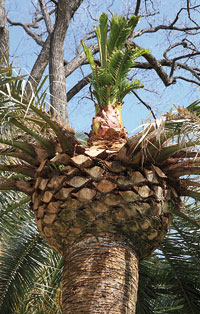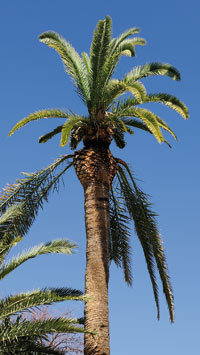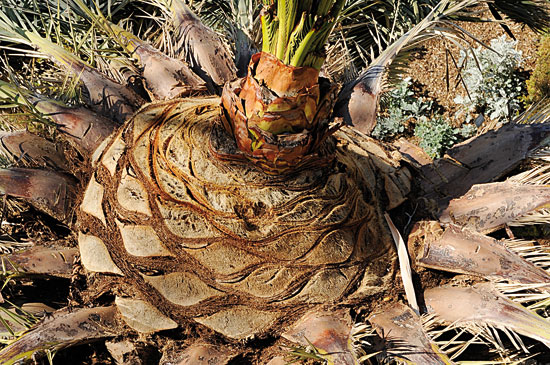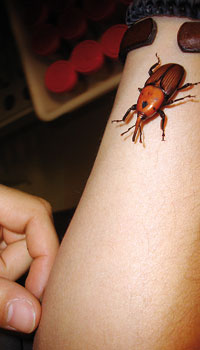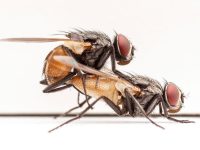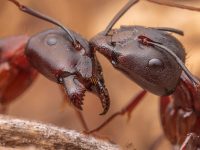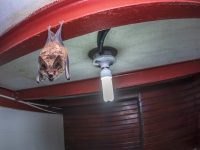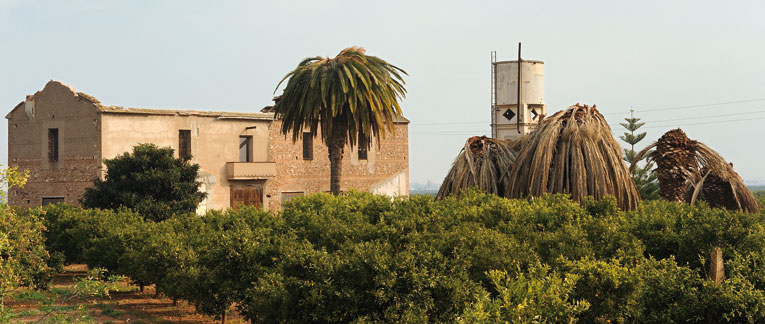
 © José Plumed |
||
|
For nearly a decade, some Mediterranean countries have had to face an environmental problem that increasingly seems more difficult to control —a red palm weevil pest (Rhynchophorus ferrugineus), an insect that has become palm trees’ worst enemy. As early as 1993 their presence was detected in the Andalusian towns of Almuñécar and Motril. In the middle of an urban development fever, streets and avenues were built and palm trees became the most requested piece of decoration for those new streets. It was at that time that the insect arrived inside imported palm trees from Egypt which, almost certainly, did not have their agrochemical passport in order. In the Valencia region the insect was detected in the year 2004. Eight years later, the crisis caused by this kind of beetle has reached a social status added to the environmental and economic problem. In fact, in contrast to other Spanish regions, in Valencia, the palm tree is considered an almost indigenous species, and the arrival of the weevil has threatened important areas such as palm grove of Elx (Alicante), which, with more than 10.000 trees, was declared heritage of humanity by UNESCO. The red palm weevil infestation has caused enormous economic and rural consequences there. This special situation has forced the Valencia region to fight this pest against the clock, a fight long fought by researchers on their own, behind their society’s back, a society unaware of the problem. Also politicians have kept out of everything, only concerned with their own party agendas, favouring the expansion of the invader insect. THE PALM TREE, A CULTURAL SYMBOL Because the palm tree is an essential element of the urban landscape of Mediterranean towns, the red palm weevil pest affects their population in a special kind of way. And we are not talking only about the particular case of Elx, but about virtually any coastal town, where its inhabitants have assimilated the presence of the palm tree as another element, typical of their own land, and linked to the Mediterranean culture. Their use has been adapted throughout time, until somehow becoming a symbol. Ever since the introduction of the grange in the Valencian farmlands, where palm trees rise as impressive watchtowers of time from the orange tree fields to the Paseo de la Explanada in Alicante, nobody can escape from associating palm trees to the Valencian landscape and culture. Some authors denounce that, since in Northern Europe palm trees are not considered indigenous plants of the continent, the European Union has undervalued the corrosive power of this pest as well as its importance, since the presence of the palm tree has been limited to the area of South-eastern Spain and Greece for centuries, where, on the other hand, an indigenous species of the country (Phoenix theophrasti) was unknown until very recently. In the Iberian Peninsula, it was introduced by the Arabs in Elx as part of their irrigation system in the 10th century. This introduction transformed the society of the time —the way of using water changed, and the fruits of palm trees were profited from then on for animal and human feeding; their leaves, for the manufacturing of baskets, brooms and espadrilles; their trunk, for the construction of beams; and their oil, as fuel. Moreover, the presence of the plant in religious rites and cultural events has also been very important. The most representative example of this practice can be noticed on Palm Sunday, a deep-rooted festival in many countries of Judeo-Christian tradition whose origin can be traced back to the Jewish festival of Tabernacles, in which a bouquet with a white palm wrapped in myrtle and white willow leaves is given as an offering. Nowadays, the white palm service is very popular in countries of Catholic tradition, and there is evidence of the use of plaited palms on Palm Sunday in Spain, England, Corsica and Germany. |
«In the Valencia region the pest has aquired a social dimension because its inhabitants see the palm tree as an essential element, indigenous to their land and linked to the Mediterranean culture»
|
|
|
|
«At the palm grove of Elx, declared heritage of humanitay by UNESCO, the weevil has caused huge economic and cultural consequences» | |
|
All in all, the researches carried out until very recently by researchers from Jaume I University of Castellon (Dembilio i Jacas, 2012) have shown that the most vulnerable species facing the red palm weevil is not the date palm —the most common in the palm grove of Elx—, nor the European fan palm —a native species of the Valencia region— but the Canary Island date palm (Phoenix canariensis), the most preferred species for the ornamentation of towns and gardens in the last century. However, it has been proven that both the date palm and the native Greek and Valencian palm trees can be affected by these insects, although to a lesser extent. Origins of the pest There are records of this insect dating from the 18th century. Its presence was confirmed in 1750 and 1776 in Sri Lanka and India. Human activity has helped to spread the weevil, which can fly for over a kilometre. They were detected in the United Arab Emirates in 1986 and, six years later, in Egypt, whence it was imported to Spain in 1993. It was recorded in the Caribbean in 2009, and, a year later, in California. When they were detected in Motril and Almuñécar, the area was declared in quarantine, but maybe it was already too late. In 2004 they were found within the Valencia region, in 2005 in Murcia, Catalonia and the Canary Islands, and in 2006 in the Balearic Islands. Where a hotspot has been detected, the growth in the red palm weevil population has been exponential, up to a point that most of the people involved in the battle against the red palm weevil have qualified the situation as «uncontrollable». The adult, whose lifespan is from 45 to 90 days, can travel either by land or by air. Attracted by palm tree kairomones, the vegetable substances that plants release due to a wound or a poor pruning, the insects go to the palm tree crown, usually in daylight, where they lay their eggs, between 300 and 500. From their birth, larvae start to burrow tunnels, which can be a metre long, inside the apical bud, which is where palm tree leaves sprout from. If this area is greatly damaged, the palm tree dies. As soon as the first visible symptoms of colonisation appear, the weevil is about to reach the next phase of its lifecycle and, using palm tree fibres, they build their cocoons in order to become pupa. Many institutions have become involved in trying to stop the invasion of the Asian ferrugineus in the Valencia region, contributing with many studies that try to decipher the population dynamics of the red palm weevil. Thus, the research carried out by Antonia Soto and Juan Antonio Ávalos in the Mediterranean Agroforestal Institute (which belongs to the Polytechnic University of Valencia) has revealed that the flight of the weevil increases in the summer, and they can be caught mainly between September and December (Borrás et al., 2011). The best time for detecting the weevil is the Autumn months, when a larger number of palm trees show the typical symptoms of the pest —young leaves from the top look as if sawn, lateral leaves fall down, and at the crown’s base we can see exuding perforations. On the other hand, the Jaume I University team led by Josep Jacas discovered that in areas with an average temperature of 15°C and 20°C, typical of Greece, Italy and the Iberian Peninsula, the insect produces two generations per year, while in a tropical climate, with an average temperature above 19°C, like in the Canary Islands, they produce more than two generations per year. These studies have helped to determine which time of the year is best for pruning (winter) and to foresee how the pest might develop in the long term. In spite of this, prevention and control methods have not yet been perfected. In the Ítica Institute from the Polytechnic University of Valencia and the Gatcom Institute from the Miguel Hernández University of Elx have developed a wireless sensor system that can detect the insect with ultrasound. The device, which sends signals to a receiver, has been useful in places like the palm grove of Elx, where the daily visual inspection of palm trees may not be enough. |
«Many citizens decide to let their palm trees die so as not to pay for its destruction, a service that was subsidised until very recently»
«The most vulnerable species is the Canarian palm tree (Phoenix canariensis), the most preferred species for the ornamentation of towns and gardens in the last century»
|
|
 © José Vicente Bernabeu From their birth, larvae burrow tunnels inside the apical bud of the palm tree. There, using the fibres of the plant, make their cocoons (picture at the top), inside which they start the next phase of their lifecycle, the pupa. In the Mediterranean Agroforestal Institute from the Polytechnic University of Valencia breed red palm weevils in order to study their behaviour, from the egg laying (on the right) until they reach the adult stage. |
«Experts agree that education is essential in order to control a pest like the red palm weevil pest» |
|
|
On the right track Even though the battle against the red palm weevil is fought against the clock, many authors plead for optimism and remind us that there are some places where the pest has been controlled. What is essential is to combine both detection and capture methods as well as a daily visual inspection of the palm trees undergoing preventive and healing treatments, both of the chemical and of the biological kind. In Kerala (India) the fight against the red palm weevil was fought in the mid 1960s with an integrated pest management that combined traps and food, monitoring of the traps, preventive chemical treatments, insecticides, eradication and education (Abraham et al., 1989). Experts agree that education is essential in order to control a pest like this one. Since it was declared in the Valencia region, both the central and the regional governments have invested millions of euros to try to eradicate it, a goal that seems impossible today. «We have to learn to live together with the weevil», said Manuel Lainez in February 2012, when he was the general director of Agrarian Production and Stock-breeding of the Generalitat Valenciana (Regional Government of Valencia). Laws and regulations have been adapted to the new situation and the regional government of Valencia has set up new help lines and contact addresses to deal with the weevil problem and has also developed some training courses to which more than a hundred town councils have adhered. However, this programme might have arrived a bit too late: the economic crisis has also affected the battle against the read palm weevil and now the owners are the ones that have to destroy the infected palm trees. The operation, which can only be carried out by companies authorised by the regional government, can cost up to 1000 euros and many citizens decide to let their palm trees die so as not to pay for a service that was subsidised until very recently. «This is a problem», explains Juan Antonio Ávalos (Mediterranean Agroforestal Institute), «because if you have a rosebush, it seems normal that you take care of it, that you watch it in case it is attacked by a pest, and ensure it doesn’t infect other bushes». An idea shared by Óscar Dembilio, from Jaume I University: «It is highly important to make people aware of the serious problem the weevil represents, because in many cases, the hotspot comes from palm trees located in private gardens in which the public administration has not been able to deal with quickly and solve the problem.» According to Dembilio, «nowadays we have the necessary tools to control the pest, we only need everyone’s collaboration». A synergic action that will be decisive in the oncoming years because, without a clear policy to boost joint projects in which all organisations are equally involved, the race against the red palm weevil will be lost. |
«Most people involved in the battle against the weevil have qualified the situation as “uncontrollable”»
«In India a red palm weevil pest was tackled in the 1960’s using an integrated pest management that combined the monitoring of traps, preventive and healing treatments and training courses for citizens»
|
|
|
BIBLIOGRAPHY José Vicente Bernabeu Pardo. Student of Journalism at the University of Valencia. |
||

